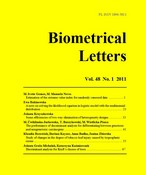
Biometrical Letters vol. 48(1), 2011, pp. 55-66


Air pollution by ground-level ozone in Poland has recently been increasing, and is connected with the increased number of cars, the main source of ozone precursors. Phytotoxic influence of this pollutant was discovered in the 1950s, when visible injuries to tobacco and grapevine leaves were observed. Bioindicative methods are very important for evaluating the air pollution level, as well as for assessment of impact of air pollutants on living organisms. The tobacco plant and its ozone-sensitive Bel W3 cultivar are well known bioindicators. This cultivar was used in the studies presented here. Plants were exposed in the Poznan city centre during the 2002-2006 growing seasons. The statistical model of multivariate analysis of variance was established in this paper to determine the differences between selected years and leaves with respect to the degree of visible tobacco leaf injury. Statistical differences in the degree of leaf injury were observed among individual years, as well as variation among exposure series during growing seasons. These differences were connected with meteorological conditions, which are one the factors promoting tropospheric ozone creation. Statistical differences of leaf injuries were not observed between individual leaves.

multivariate analysis of variance, canonical variates, tropospheric ozone, bioindication

